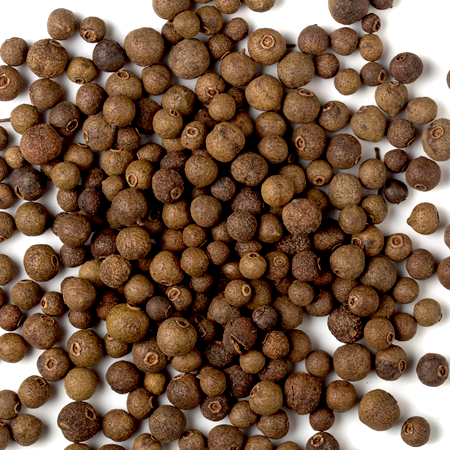

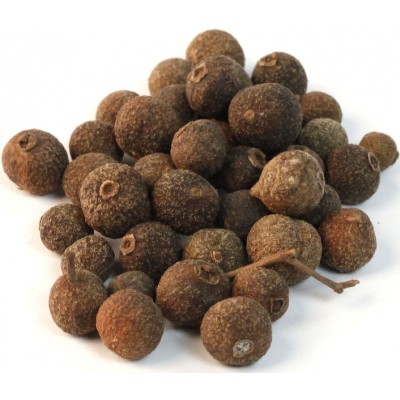
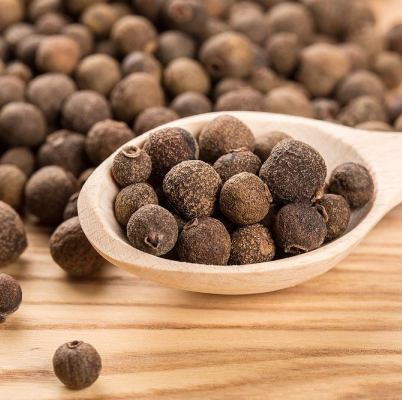
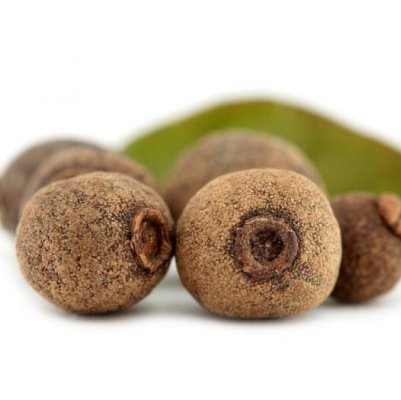
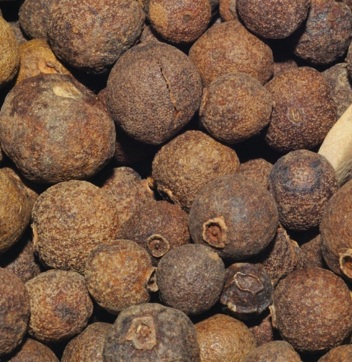
Botanical name Pimento officinalis
Family Myrtaceae
Source Berries
Origin West Indies
Processing Method Steam Distilled
Color/Consistency Pale yellow to yellow-amber liquid.
Aromatic Summary / Note / Strength of Aroma Sweet and spicy, it gives a middle note with a medium aroma.
Blends With Ginger, Geranium, Lavender, Orange, Patchouli and Ylang-Ylang.
Product Abstract
The spicy aroma of Allspice Essential Oil is quite similar to clove and cinnamon essential oils and that is primarily because of the presence of Eugenol. It is used in diffusers, but mostly in mild form. A concentrated form may irritate mucous membrane and is not advisable. In small concentrations, the oil is an excellent aphrodisiac.
History
Allspice berries were first discovered by Christopher Columbus. At first, he thought that he had stumbled upon a new species of pepper. It happened during his second voyage to the New World. Allspice was introduced into European and Mediterranean cuisines in the 16th century. Right after that, it has been primarily cultivated in Jamaica.
Harvesting/Extraction Information
The allspice tree can be grown outdoors in the tropics and subtropics using normal garden soil and regular watering. Although smaller plants are attacked by frost, the larger plants are more resilient. Allspice oil (from both the leaf and the fruit) is extracted by steam distillation. An oleoresin from the berries is also produced in small quantities.
Common Usage
Caution
Dilute before use; for external and internal use only. May cause skin irritation in some individuals; a skin test is recommended prior to use. Contact with eyes should be avoided.
Key constituents
Eugenol 67.0–80.0%
Methyleugenol 2.9–13.1%
b-Caryophyllene 4.0–6.6%
(þ)-Limonene tr–4.2%
1,8-Cineole 0.2–3.0%
a-Phellandrene 0–1.8%
Terpinolene 0.1–1.5%
a-Caryophyllene 0–1.5%
a-Selinene 0–1.0%
b-Selinene 0–1.0%
Safety summary
Hazards Potentially carcinogenic, based on methyleugenol content; may inhibit blood clotting; skin sensitization (moderate
risk); mucous membrane irritation (moderate risk).
Contraindications Should not be taken in oral doses.
Maximum dermal use level
EU 0.0015%
IFRA 0.003%
Tisserand & Young 0.15%
Our safety advice
We recommend a dermal maximum of 0.15%, based on 13.1% methyleugenol content with a dermal limit of 0.02%.
Regulatory guidelines
IFRA recommends a dermal limit for eugenol of 0.5% for both leave-on and rinse-off products, in order to avoid skin sensitization. IFRA recommends a maximum concentration of 0.0004% methyleugenol in leave-on products such as body lotions. The equivalent SCCNFP maximum is 0.0002%.
Organ-specific effects
Adverse skin reactions Pimento berry oil was neither irritant nor sensitizing when patch tested on a panel of 32 volunteer at 8%. Eugenol is a potential cause of skin sensitization in dermatitis patients. Pimento berry oil is not phototoxic.
Cardiovascular effects Eugenol is a powerful inhibitor of platelet aggregation, an essential step in the blood clotting cascade.
Systemic effects
Acute toxicity No information found.
Antioxidant/pro-oxidant activity Two pimento berry oils, containing 74.7% and 73.4% eugenol and 4.1% and 9.5%methyleugenol, scavenged DPPH radicals and ABTS radicals showing excellent antioxidant activity.
Carcinogenic/anticarcinogenic potential In mouse micronucleus tests, pimento berry oil showed no genotoxicity. Methyleugenol is a rodent carcinogen when exposure is sufficiently high; eugenol, (þ)-limonene and a-caryophyllene display anticarcinogenic activity.
Comments
The berries of this plant are known as allspice, and yield pimento berry oil, which has a superior odor and taste to the leaf oil. This should not be confused with the berries of Pimenta racemosa, or West Indian bay oil, which in turn is sometimes confused with Laurus nobilis oil.